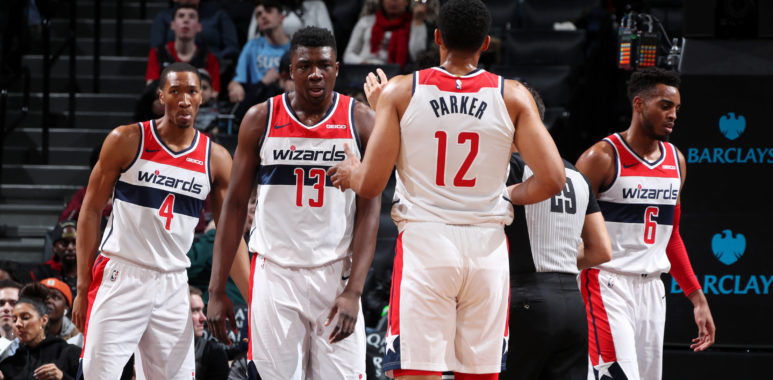
Jabari Parker is thriving, but where does he fit?
It feels like Jabari Parker has been around for ages. In the last however-many years, the Chicago native has experienced: high school stardom at Simeon Academy, (brief) college stardom at Duke, a torn ACL, a promising couple of years in the NBA, another torn ACL, a move to his hometown Chicago Bulls, a standoff with noted drill sergeant Jim Boylen, and a trade to the Washington Wizards.
But Parker only turned 24 last week. He’s somehow a full year younger than Pascal Siakam. And as much as “Jabari Parker” seems like a household name, where that name fits in the modern NBA is still a mystery. His 20-point-per-game breakout year in 2016-17 billed him as the Robin to Giannis Antetokounmpo’s Batman. But then came the second ACL tear and, upon his return in 2018, constant questions about his defense and attitude. He went from “feature scorer” to “all-around pariah” in just a few months in Chicago.
The move to Washington feels like a fresh start. The Wizards may be underwhelming, but they aren’t a circus. The sports media market in DC is sleepy, and expectations are low.
And Parker’s not only away from the spotlight, but also hidden on Washington’s second unit, finding his legs with a bunch of journeymen and youngsters. That seems like a decent spot for the fifth-year vet, at least for now.
Without an established backup floor general at his disposal, Scott Brooks has empowered Parker to generate offense at all three levels. He’ll occasionally handle the responsibilities of an old-school center, taking simple duck-ins or flowing from a half-assed screen into post position. He’s ranked among the top 20 percent of the NBA in post efficiency for four straight years, pouring in at least one point per possession in each season.
The Duke product is stocky, physical, and has a nose for the front of the hoop. He’ll deliver one or two shots to the chest, contort his upper-body to evade flailing arms, and then caress the ball in with his natural touch.
powered by Advanced iFrame free. Get the Pro version on CodeCanyon.
But Brooks is using Parker in other, more imaginative ways, too. The Washington coach has installed this early-clock handoff that gets his new sixth man some breathing room at the top of the arc.
powered by Advanced iFrame free. Get the Pro version on CodeCanyon.
Parker has orchestrated big-big and even big-small pick-and-rolls, something most backup forwards just aren’t equipped to defend. Those plays leave him free to attack a retreating defense with herky-jerky dribble moves and powerful drives.
powered by Advanced iFrame free. Get the Pro version on CodeCanyon.
In the 20 possessions he’s finished as a pick-and-roll ballhandler with the Wizards, Parker has scored 20 points, which would rank in the 88th percentile leaguewide in efficiency, per Synergy.
The overall results have been solid. Since the move, Parker’s averaged 14.5 points, 7.4 rebounds, and 3.1 assists on 61.7 percent true shooting, dwarfing his career efficiency numbers.
Individual metrics and team success don’t always mesh, though. With Parker as the primary creator – for statistical purposes, that means without Bradley Beal on the floor – the Wiz have scored an abysmal 96.4 points per 100 possessions. He’s drawing defenders with his face-ups, post-ups, and probing pick-and-roll play. He’s even passing, tallying 5.0 assists per 36 minutes in Beal-less action. But the team can’t score.
It’s a different story with Beal on the court. The Wizards have posted an elite 116.3 offensive rating when both dudes play. Parker’s usage and assist rate drop, and his turnover numbers balloon. It works anyway.
That’s not terribly surprising. Many of Parker’s best moments on an NBA court have come outside, or even against, the flow of a normal offense. He has a stampeding transition game, and he’s confident waving off his point guard and taking the ball coast-to-coast for momentum-swinging buckets.
powered by Advanced iFrame free. Get the Pro version on CodeCanyon.
At 245 pounds with stealthy acceleration, he drives right past lazy closeouts.
powered by Advanced iFrame free. Get the Pro version on CodeCanyon.
Some teams don’t even guard him because of his career 34.2 percent shooting from beyond the arc. But he finds ways to contribute anyways. He’s a resourceful, mercurial, multi-talented scorer. He’s creative. Even when defenders sink into the paint, confident in the knowledge Parker’s jumper will let him down, the 24-year-old will dance along the baseline for putbacks or improvised post-ups.
But he’s not a creator. His greatest strength, at least right now, lies in generating offense in ways the defense never expects. He’s not quite ready to generate offense through more conventional and predictable, yet also more sustainable, channels.
He doesn’t draw fouls as a ballhandler – he’s taken just four free throws in 130 minutes without Beal – and his passes out of isolation or the pick-and-roll don’t lead to shots at the rim or uncontested threes.
That’s fine. Parker has played just 15 games, and he might still become an A+ sixth man. Growing as a player takes some amount of trial and error. Plus, even with some subpar three-point shooting and the burden of leading a patchwork bench unit, the Chicago native has been one of Washington’s best players over the last month.
But for now, he’s a supporting piece capable of masquerading in a starring role, not vice-versa.
